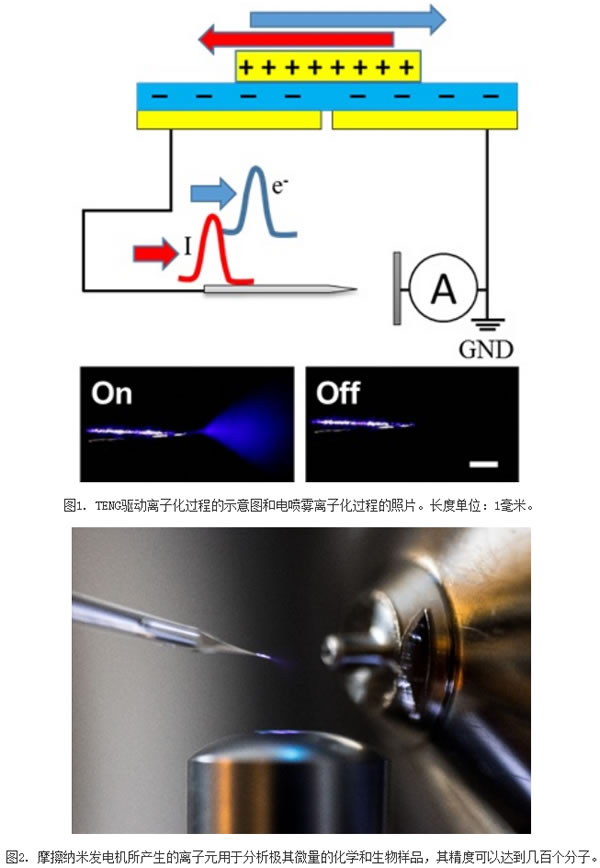At present, as a key analytical technology, mass spectrometry has been widely used in biomedicine, food science, homeland security, system biology, drug discovery and other fields. Mass spectrometry is an analytical method based on the mass-charge ratio (m/z), which has the advantages of high sensitivity, high accuracy, and universal applicability.
In mass spectrometry, ionization is a critical first step in charging neutral molecules. Most commercial ionization methods today rely on direct current (DC) high pressure to convert sample molecules to gas phase ions in the ion source. However, in the ionization process, the number of ions (Q) is not controlled by the voltage (V). Therefore, all current ionization methods do not achieve precise control of the amount of ions. Moreover, if traditional high voltage power supplies are used, the vast majority (99%) of the charge/current and ions are wasted. Therefore, mass spectrometry currently has a major bottleneck in improving the sensitivity, sample utilization, and duty cycle. In addition, the conventionally used high-voltage power supplies have disadvantages such as high cost, difficulty in carrying, and insecurity.
The high voltage output of a fixed charge is exactly one of the essential characteristics of a triboelectric nanogenerator (TENG). Under the joint guidance of Wang Zhonglin and Facundo Fernández of the Beijing Institute of Nano Energy and Systems, Chinese Academy of Sciences and Georgia Institute of Technology, Li Anxuan and Jin Yunlong formed a trans-college cooperative team to use TENG to drive the ion source to realize the ion source's charge quantity, positive and negative electrodes. The precise control of sex, signal length and many other aspects. This work provides a completely new controllable parameter for mass spectrometry analysis and is also the first application of nanogenerators in large analytical instruments. Related work has opened up new areas of research and application and was recently published in the latest issue of Nature Nanotechnology (Figure 1).
First, the team successfully implemented electrospray ionization and plasma discharge ionization using TENG. The fixed charge provided by TENG gives unprecedented control over the ionization process. The team realized controlled ion generation of nanoColoumbs and proposed relevant physical models. Through the TENG drive, the ion pulse duration, frequency, and chargeability can all be effectively controlled and sample consumption minimized. The tiny charge of TENG avoids the common corona discharge phenomenon under DC high voltage in mass spectrometry, and thus realizes ultra high voltage (5-9 kV) nano electrospray for the first time. This method improves the sensitivity of the electrospray ion source at low concentrations and maximizes sample utilization. The TENG-driven ionization mass spectrometry has been successfully used to detect various organic small molecules and biological macromolecules, and has reached the sensitivity of detecting hundreds of molecules. TENG-driven AC ion sprays are also used to deposit ionic materials on insulating surfaces.
The study is groundbreaking for the development of both mass spectrometry and TENG.
First, the study for the first time achieved accurate control of the amount of charge during the ionization process, bringing a completely new controllable parameter for mass spectrometry analysis, improved analytical accuracy, and the ability to analyze very small amounts of samples for chemical and biological detection. The bottleneck problem of the mass spectrometry method offers new possibilities. And, using TENG allows researchers to synchronize the spray time with the mass spectrometry analysis time to maximize sample utilization.
At the same time, TENG replaces the original ion spray power supply on the mass spectrometer, which makes it possible for small mass spectrometers to be portable and possible under extreme conditions such as military or aerospace applications.
Finally, the study as the first study to use TENG in equipment and instruments confirmed that TENG is a simple, safe and effective method for providing high voltage, providing ideas for similar research, driving different instruments for TENG and The process thus lays the foundation for a "controllable self-driven system".
Paper Information: A. Li*, Y. Zi*, H. Guo, ZL Wang#, FM Fernández #, Triboelectric Nanogenerators for Sensitive Nano-Coulomb Molecular Mass Spectrometry, Nature Nanotechnology, DOI: 10.1038/NNANO.2017.17 (2017).

Passenger elevator refers to the elevator designed for transporting passengers, which requires perfect safety facilities and certain interior decoration. It is divided into low speed ladder, medium speed ladder and high speed ladder. China Passenger Elevator,Residential Passenger Lifts manufacturers, welcome Electric Passenger Lift,Passenger Elevator Lift purchasers from worldwide to visit our site.
Passenger Elevator,Residential Passenger Lifts,Electric Passenger Lift,Passenger Elevator Lift
Suzhou Stable Trade Co., Ltd , https://www.stable-elevator.com
